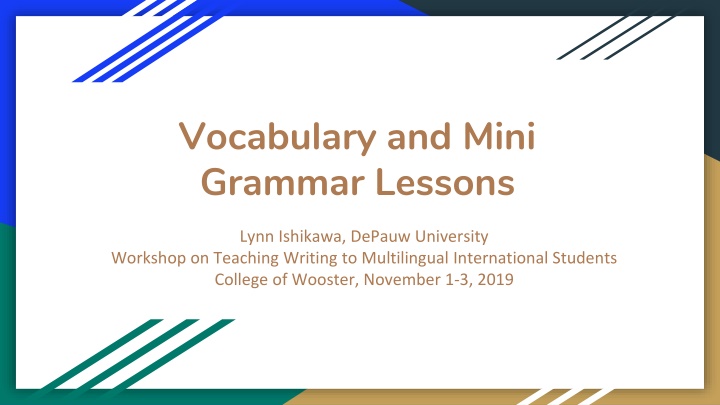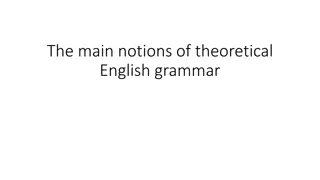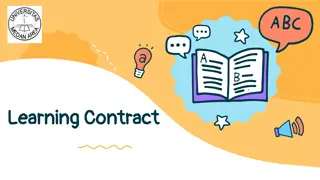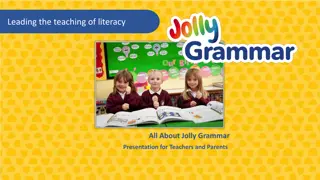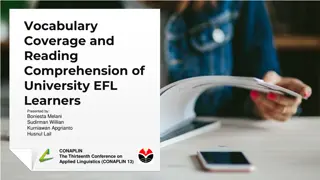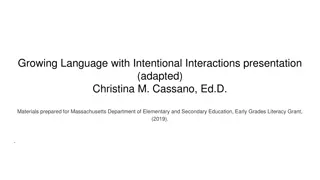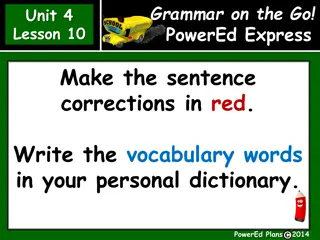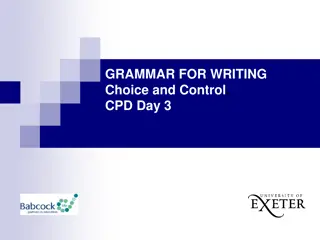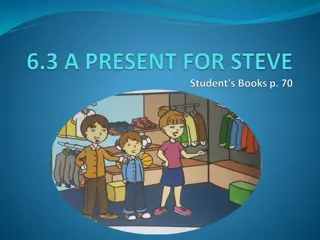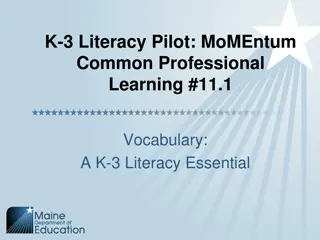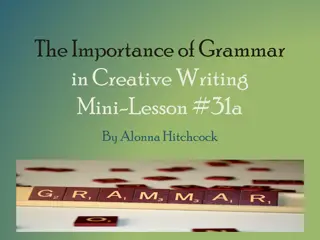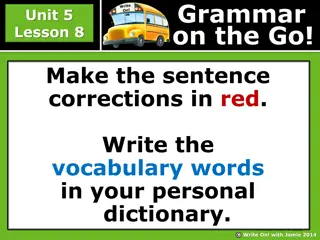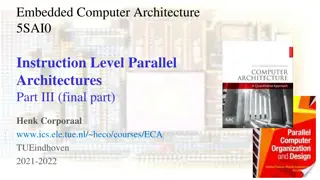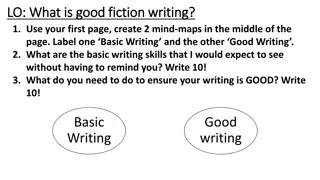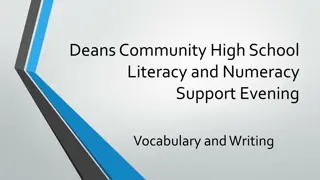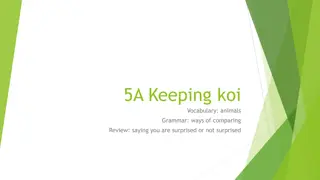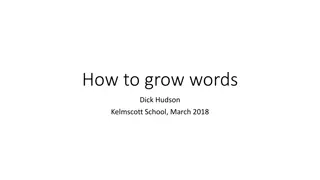Enhancing Writing Skills Through Grammar and Vocabulary Instruction
Essential role of grammar and vocabulary in writing courses for multilingual students. Gain insights into rethinking students' needs, selecting effective instructional strategies, and integrating language work seamlessly into writing instruction.
Download Presentation

Please find below an Image/Link to download the presentation.
The content on the website is provided AS IS for your information and personal use only. It may not be sold, licensed, or shared on other websites without obtaining consent from the author.If you encounter any issues during the download, it is possible that the publisher has removed the file from their server.
You are allowed to download the files provided on this website for personal or commercial use, subject to the condition that they are used lawfully. All files are the property of their respective owners.
The content on the website is provided AS IS for your information and personal use only. It may not be sold, licensed, or shared on other websites without obtaining consent from the author.
E N D
Presentation Transcript
Vocabulary and Mini Grammar Lessons Lynn Ishikawa, DePauw University Workshop on Teaching Writing to Multilingual International Students College of Wooster, November 1-3, 2019
If we have expectations about students sentence level language ... We need to make sure students know this We need to be explicit about those expectations We need to teach students how to meet those expectations This does not require expertise in grammar
Overview The place of grammar and vocabulary in a writing course and the context for this module Changing the way we think about error and correctness Incorporating language work into a writing course: What do students need in your course? Concrete examples to use with vocabulary and grammar instruction Mapping your course
Mapping your course -- a preview Consider the vocabulary and/or grammar students need within your course and discipline Examine course texts to find models of vocabulary and grammar Choose points in the syllabus where vocabulary and grammar instruction could be added Design in-class activities to promote noticing, provide instruction, and allow for practice of the target vocabulary or grammar
Rethinking what students need -- Ferris, 2011 Multilingual writers need: Help with higher order concerns and language More than just correction of errors in their writing (at the end of the writing process)
Ferris, 2011, p.188 Teachers of L2 writers in particular must go beyond top-down higher- order concerns and even beyond the treatment of error in their students texts. L2 writers are simultaneously learning to compose and acquiring more proficient control of the L2 itself. This is a task of great difficulty and complexity, one that advanced writers of their own primary language (i.e., many teachers of L2 writers) tend to underestimate.
Grammar and vocabulary instruction in a writing course Should be selective Should be directly connected to writing We can begin by concentrating on those categories which have the most pedagogical utility (Noguchi, 1991, p. 19).
The importance of lexical bundles -- Cortes, 2004 Academic language varies across disciplines Disciplinary scholars identify particular lexical bundles as markers of good writing Both native and non-native speakers tend to misuse or underuse these lexical bundles
Cortes, 2004 Examples of lexical bundles: History: the extent to which, as a result of, from the perspective of, in the wake of, at a time when, to the extent that (p. 405) Biology: a function of the, presence or absence of, the degree to which, with respect to the, is a function of, may be due to (p. 407)
Changing the way we think about error Focus on awareness over performance (Ellis, 2002). Errors are both a natural and inevitable consequence of the process of [language] acquisition (p. 22) Teach students the conventions of the discipline when it will help them communicate meaning, but value students unique voice over standards and conventions The goal is to help Ss make choices about grammar for rhetorical purposes rather than to simply conform to an expected standard (Balester, 2012, p. 73) Focus on readability and rhetorical effectiveness rather than error, standards, and rules (Balester, 2012, p. 74)
Incorporating language work into a writing course: What do students need? Incorporating language work into a writing syllabus (Ferris, 2018, p. 96) During discussion of a reading (e.g. What language choices did the author make and why? When introducing a writing assignment (e.g. What language should students use in this paper?) Before a peer-editing session (e.g. Which language features should students look for in the session?) After returning a graded assignment (e.g. What were some common errors in this group of papers?)
Incorporating language into a writing course: Things to keep in mind Most faculty work with language only when they correct errors. Instead, think of correcting errors as only one part of language development work in the course (Ferris, 2011, p. 160) Course reading and past student writing can be a good way to model specific vocabulary and grammar (e.g. passive or active voice, using present tense to introduce a text, etc.)
Questions for reflection 1. What concerns do you have, if any, about incorporating some kind of vocabulary or grammar instruction into your course? 2. Do you have expectations about students language use and grammatical correctness in written work? How might you rethink these expectations within the the context of this module?
Teaching Vocabulary Teach in conjunction with reading Choose important terms for engaging with course material (both reading and writing) Identify common lexical bundles in your discipline
Brainstorm a list of key words or terms for a specific course
Teaching Grammar Recognize the grammar in your discipline Point out key structures in reading Teach mini grammar lessons
Example: Modals I. Explain Modals are important in academic writing because they show the difference between facts, assumptions, and possibilities and also because they can be used to hedge. (can, could, might, may, should, etc.) Example 1: More specifically, it could compromise the rights of second language writers to receive appropriate instruction that would help expand their language resources . (Matsuda, 2021, pg. 110). Example 2: What should we make of these results?
Modals continued II. Discover How to Stop Superhuman AI Before It Stops Us, Stuart Russell, NYT October 8, 2019 https://www.nytimes.com/2019/10/08/opinion/artificial- intelligence.html Underline the modals you find Discuss select examples and why the author made that choice
Modals continued III. Examine Have students examine their own writing and underline modals, or use a sample of anonymous student writing for everyone to look at. Ask students to discuss the choices they made in using or not using modals and the effect of those choices.
Modals continued IV. Practice Ask students to edit sample sentences or a short passage to correct errors in construction or usage. Do an in-class free-write about possible alternative directions and life choices in which the use of modals would be a natural choice (Hyland, 2008, p. 85) Edit a passage to insert or remove modals and discuss the ways this changes the meaning and/or tone of the text (Hyland 2008, p. 83).
Modals -- Practice continued Have students rewrite passages from texts with the goal of presenting either tentative or certain conclusions (Hyland, 2008, p. 84). Consider longer assignments that require students to use the grammatical structure. In the case of modals, possibilities include writing an op ed, responding to a manifesto, or offering predictions about new technology (Hyland, 2008, p. 85).
Modals continued V. Review Correct/go over together as a group.
Mapping your course Consider the vocabulary and/or grammar students need within your course and discipline Examine course texts to find models of vocabulary and grammar Choose points in the syllabus where vocabulary and grammar instruction could be added Design in-class activities to promote noticing, provide instruction, and allow for practice of the target vocabulary or grammar
References Balester, V. (2012). How writing rubrics fail: Toward a multicultural model. In A. B. Inoue and M. Poe (Eds.), Race and writing assessment(pp. 63-77). Peter Lang. Cortes, V. (2004). Lexical bundles in published and student disciplinary writing: Examples from history and biology. English for Specific Purposes, 23, 397-423. ScienceDirect, doi: 10.1016/j.esp.2003.12.001 Ellis, R. (2002). The place of grammar instruction in the second/foreign language curriculum. In E. Hinkel & S. Fotos (Eds.), New perspectives on grammar teaching in second language classrooms (pp. 17-34). Routledge. Ferris, D.R. (2011). Treatment of error in second language writing (2nd ed.). University of Michigan Press Ferris, D.R. (2018). Building a writing curriculum and developing strategic writers. In Teaching English to Second Language Learners in Academic Contexts: Reading, writing, listening, and speaking (pp. 89-105). Routledge.. Hyland, K. (2008). Myth 4: Make your academic writing assertive and certain. In J. Reid (Ed.), Writing myths: Applying second language research to classroom teaching (pp. 70-89). University of Michigan Press. Matsuda, P.K. (2021). Weathering the translingual storm. In T.J. Silva & Z. Wang (Eds.), Reconciling translingualism and second language writing(pp. 103-116). Routledge. Noguchi, R. (1991). Grammar and the teaching of writing: Limits and Possibilities. Urbana, IL: National Council of Teachers of English. Russell, S. (2019 October). How to stop superhuman AI before it stops us. The New York Times. https://www.nytimes.com/2019/10/08/opinion/artificial-intelligence.html.
